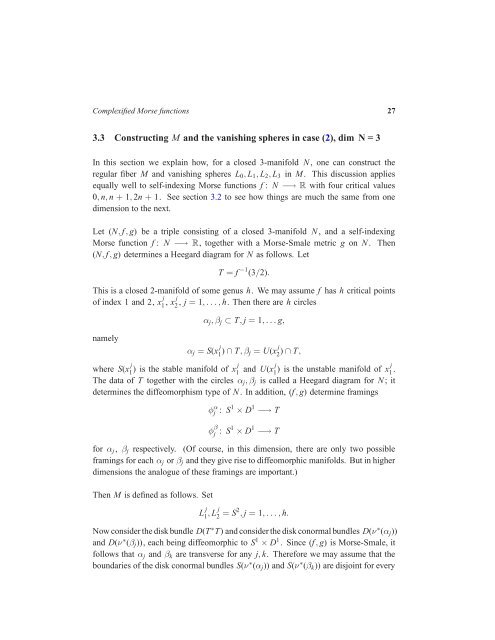The Picard-Lefschetz theory of complexified Morse functions 1 ...
The Picard-Lefschetz theory of complexified Morse functions 1 ...
The Picard-Lefschetz theory of complexified Morse functions 1 ...
You also want an ePaper? Increase the reach of your titles
YUMPU automatically turns print PDFs into web optimized ePapers that Google loves.
Complexified <strong>Morse</strong> <strong>functions</strong> 27<br />
3.3 Constructing M and the vanishing spheres in case (2), dim N = 3<br />
In this section we explain how, for a closed 3-manifold N , one can construct the<br />
regular fiber M and vanishing spheres L0, L1, L2, L3 in M. This discussion applies<br />
equally well to self-indexing <strong>Morse</strong> <strong>functions</strong> f : N −→ R with four critical values<br />
0, n, n + 1, 2n + 1. See section 3.2 to see how things are much the same from one<br />
dimension to the next.<br />
Let (N, f, g) be a triple consisting <strong>of</strong> a closed 3-manifold N , and a self-indexing<br />
<strong>Morse</strong> function f : N −→ R, together with a <strong>Morse</strong>-Smale metric g on N . <strong>The</strong>n<br />
(N, f, g) determines a Heegard diagram for N as follows. Let<br />
T = f −1 (3/2).<br />
This is a closed 2-manifold <strong>of</strong> some genus h. We may assume f has h critical points<br />
, j = 1,... , h. <strong>The</strong>n there are h circles<br />
<strong>of</strong> index 1 and 2, x j j<br />
1 , x2 namely<br />
where S(x j<br />
1<br />
αj,βj ⊂ T, j = 1,... g,<br />
αj = S(x j<br />
) is the stable manifold <strong>of</strong> x j<br />
1<br />
1 ) ∩ T,βj = U(x j<br />
2 ) ∩ T,<br />
and U(x j<br />
1<br />
) is the unstable manifold <strong>of</strong> x j<br />
1 .<br />
<strong>The</strong> data <strong>of</strong> T together with the circles αj,βj is called a Heegard diagram for N ; it<br />
determines the diffeomorphism type <strong>of</strong> N . In addition, (f, g) determine framings<br />
φ α j : S1 × D 1 −→ T<br />
φ β<br />
j : S1 × D 1 −→ T<br />
for αj , βj respectively. (Of course, in this dimension, there are only two possible<br />
framings for each αj or βj and they give rise to diffeomorphic manifolds. But in higher<br />
dimensions the analogue <strong>of</strong> these framings are important.)<br />
<strong>The</strong>n M is defined as follows. Set<br />
L j j<br />
1 , L2 = S2 , j = 1,... , h.<br />
Now consider the disk bundle D(T ∗ T) and consider the disk conormal bundles D(ν ∗ (αj))<br />
and D(ν ∗ (βj)), each being diffeomorphic to S 1 × D 1 . Since (f, g) is <strong>Morse</strong>-Smale, it<br />
follows that αj and βk are transverse for any j, k. <strong>The</strong>refore we may assume that the<br />
boundaries <strong>of</strong> the disk conormal bundles S(ν ∗ (αj)) and S(ν ∗ (βk)) are disjoint for every
















